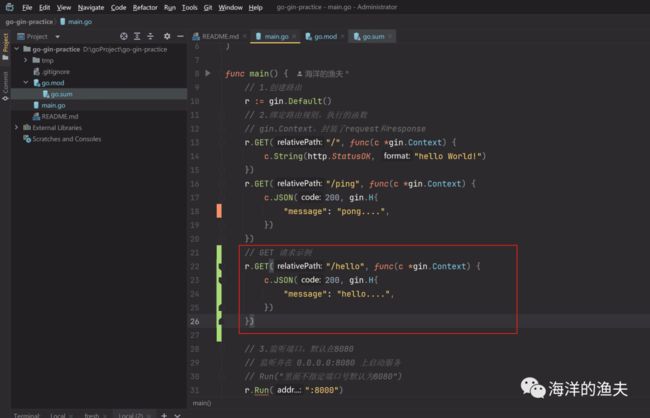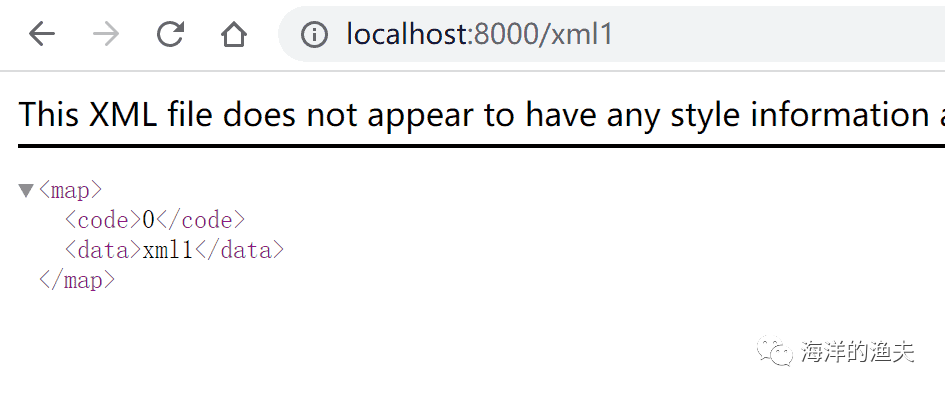3.Gin 框架中的路由简要说明
3.Gin 框架中的路由简要说明
Gin 框架中的路由
路由概述
路由(Routing)是由一个 URI(或者叫路径)和一个特定的 HTTP 方法(GET、POST 等)
组成的,涉及到应用如何响应客户端对某个网站节点的访问。
RESTful API 是目前比较成熟的一套互联网应用程序的 API 设计理论,所以我们设计我们的路
由的时候建议参考 RESTful API 指南。
在 RESTful 架构中,每个网址代表一种资源,不同的请求方式表示执行不同的操作:
| GET(SELECT) | 从服务器取出资源(一项或多项) |
|---|---|
| POST(CREATE) | 在服务器新建一个资源 |
| PUT(UPDATE) | 在服务器更新资源(客户端提供改变后的完整资源) |
| DELETE(DELETE) | 从服务器删除资源 |
简单的路由配置
简单的路由配置
GET 请求示例
 1695656801157
1695656801157
// GET 请求示例
r.GET("/hello", func(c *gin.Context) {
c.JSON(200, gin.H{
"message": "hello....",
})
})测试如下:
curl -X GET http://localhost:8000/hello 1695657576419
1695657576419
POST请求示例
// POST 请求示例
r.POST("/add", func(c *gin.Context) {
c.JSON(http.StatusOK, gin.H{
"message": "add",
})
})测试如下:
curl -X POST -H "Content-Type: application/json" http://localhost:8000/addPUT请求示例
// PUT 请求示例
r.PUT("/put", func(c *gin.Context) {
c.JSON(http.StatusOK, gin.H{
"message": "put",
})
})测试如下:
curl -X PUT -H "Content-Type: application/json" http://localhost:8000/put 1695658030962
1695658030962
DELETE请求
// DETELE 请求示例
r.DELETE("/delete", func(c *gin.Context) {
c.JSON(http.StatusOK, gin.H{
"message": "delete",
})
})测试如下:
curl -X DELETE -H "Content-Type: application/json" http://localhost:8000/delete 1695658161530
1695658161530
获取query参数、路径参数
路由里面获取 Query 参数
// GET 获取query参数示例
r.GET("/user", func(c *gin.Context) {
// 获取query参数
uid := c.Query("uid")
// 返回响应信息
c.JSON(http.StatusOK, gin.H{
"message": fmt.Sprintf("uid=%s", uid),
})
})测试如下:
curl -X GET http://localhost:8000/user?uid=test001 1695660194092
1695660194092
获取动态路由的路径参数
// GET 获取path路径参数
r.GET("/book/:bid", func(c *gin.Context) {
// 获取path参数
bid := c.Param("bid")
// 返回响应信息
c.JSON(http.StatusOK, gin.H{
"message": fmt.Sprintf("bid=%s", bid),
})
})测试 如下:
curl -X GET http://localhost:8000/book/bid001 1695660700658
1695660700658
路由响应数据:c.String() c.JSON() c.JSONP() c.XML() c.HTML()
c.String() 返回一个字符串
“在上面的代码示例中,其实已经使用过了。
”
// c.String 响应内容为字符串
r.GET("/news", func(c *gin.Context) {
// 获取参数
aid := c.Query("aid")
// 返回字符串
c.String(http.StatusOK, "aid=%s", aid)
})测试如下:
curl -X GET http://localhost:8000/news?aid=aid001 1695740680020
1695740680020
c.JSON() 返回 JSON 字符串
r.GET("/json1", func(c *gin.Context) {
// 使用 map[string]any 返回json内容
c.JSON(200, map[string]any{
"code": 0,
"data": "json1",
})
})
r.GET("/json2", func(c *gin.Context) {
// gin.H 是 map[string]any的缩写
c.JSON(200, gin.H{
"code": 0,
"data": "json2",
})
})
r.GET("/json3", func(c *gin.Context) {
// 使用结构体设置JSON结构
var msg struct {
Name string `json:"user"` // 使用`json:"user"` 定义json字符串返回的别名,例如Name在json字符串中为user
Message string `json:"message"`
Age int `json:"age"`
}
msg.Name = "lijw"
msg.Message = "Hello world!"
msg.Age = 18
// 使用结构体对象,返回JSON数据
c.JSON(http.StatusOK, msg)
})测试如下:
curl -X GET http://localhost:8000/json1
curl -X GET http://localhost:8000/json2
curl -X GET http://localhost:8000/json3 1695741515412
1695741515412
c.JSONP() 返回回调JSON
// c.JSONP() 返回回调JSON
r.GET("/JSONP", func(c *gin.Context) {
data := map[string]interface{}{ "foo": "bar", }
// /JSONP?callback=x
// 将输出:x({\"foo\":\"bar\"})
c.JSONP(http.StatusOK, data)
})测试如下:
curl -X GET http://localhost:8000/JSONP
curl -X GET http://localhost:8000/JSONP?callback=x 1695741865466
1695741865466
c.XML() 返回 XML 数据
// c.XML() 返回 XML 数据
r.GET("/xml1", func(c *gin.Context) {
// 方式一:手动拼接JSON
c.XML(http.StatusOK, gin.H{
"code": 0,
"data": "xml1",
})
})
r.GET("/xml2", func(c *gin.Context) {
// 方法二:使用结构体
type MessageRecord struct {
Name string `xml:"name"`
Message string `xml:"data"`
Age int `xml:"age"`
}
var msg MessageRecord
msg.Name = "lijw"
msg.Message = "Hello world!"
msg.Age = 18
// 返回XML格式内容
c.XML(http.StatusOK, msg)
})测试如下:
http://localhost:8000/xml1
 1695742445725
1695742445725
http://localhost:8000/xml2
 1695742466927
1695742466927
c.HTML 渲染模板
创建用于渲染的模板html
 1695745504219
1695745504219
templates/index.html
Title
index
渲染的内容: {{.title}}